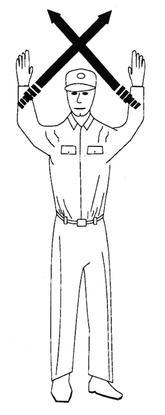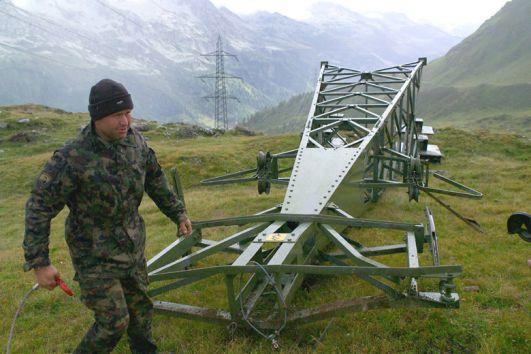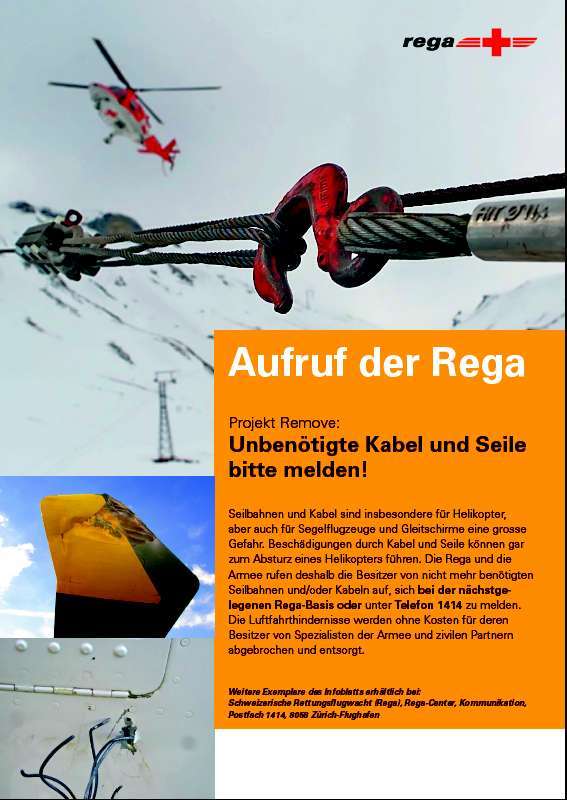Rotor blades and deadly wires
Memorandum ad Wire Strikes
This is a document I wrote in 2014 after the tragic accident on Sollihøgda, Norway, which took down one of the Norwegian Air Ambulance (NLA) AS helicopters. The article was written long before an official statement came into place and before the commission of inquiry made recommendations. It is not aimed at NLA, but I reproduce an excerpt here because the issue is still a major challenge among helicopter operations of all kinds.
My training as a HEMS Technical Crew Member in the Alps sensitized me to the seriousness of the subject of "wires". Scary stories of experienced colleagues always included at least one episode where cables and rotor were mentioned in the same sentence. Where I could, I therefore passed on knowledge on how to requisition helicopters to lay people, such as aid corps, hikers in the mountains, and professional agencies such as the police and fire brigade through various courses. The aim of the memo is to highlight some of the measures that exist to further minimize the problem of "wire strikes". I hope that this memo is not seen as a know-it-all outsider, but an attempt to contribute something that might give useful input.
Various measures
Here I would like to highlight some systems and measures that exist in other countries. Sources mostly come from internet searches as well as personal knowledge.
Audiovisual warning
There are a number of systems that provide an audiovisual warning against aviation obstacles such as the Swiss FLARM (Portable Collision Avoidance System), the most used system in helicopters is the FLOICE system. (https://www.flarm.com/), which is comparable to TCAS, but independent of radar, and which has full integration into the intercom. In addition, the device saves the flight path in 3D as a log file. (Unknown if implemented in NLA's helicopters).
However, these require that the obstacle is listed in the map system, i.e. has a known position and needs GPS support. Price per unit depends somewhat on additional features, but is around EUR 2,000.
REGA (the air ambulance service in Switzerland) has major challenges, such as many spans between narrow valleys, and cable cars set up by farmers who are not registered for registration (short-term, e.g. transporting hay, old telephone cables, etc.), or are exempt the requirement for reporting. REGA uses FLOICE on its fleet to good effect. However, emergency landings have been reported, where the system failed due to lack of registered cables (Newspaper article, Obwalden und Nidwalden Zeitung, 2010).
Other systems such as the OCAS System are known from wind farms (also in Norway). But these systems must be installed on or at the obstacle and contain some form of radar.
The following patent (US 5371581 A), with the name "Helicopter obstacle warning system" uses a rotating laser distance meter that is mounted under the helicopter and, like the other existing warning devices, provides an audiovisual alarm, but is completely independent of a database.
Similar systems exist on the market and are sold e.g. by the company Cassidian (Germany. From 2014: Airbus Defense & Space group (formerly EADS)). (Wikipedia. 2014). Called "laser obstacle warning system".

This system is mounted on the NH-90 helicopter that Norway also uses on its frigates. It is unknown whether the unit has received civil approval. Price and weight per unit are also unknown. With a size of approx. At 30x40x30cm, the unit is relatively large, in addition to the fact that it must be mounted on the front of the helicopter. The author cannot comment on the time needed for implementation, since the rules regarding registration processes and individual approvals [in commercial aviation] concerning the Norwegian Civil Aviation Authority are unknown. Therefore, assumed values are used. Disadvantages will be size and weight, as well as a lack of multi-use areas, i.e. cost/benefit function: Such equipment cannot be used for purposes other than "seeing" obstacles.
Political engagement
The air ambulance service ("LAT") is state-owned in Norway and organized under the Norwegian Air Ambulance Trust (ANS). Operators compete for tenders every 5 years.
A solution that makes use of political and community contacts is to influence the authorities to require labeling of aviation obstacles that are lower than the current requirements. Since Norway has such an extensive power grid (air struck!) it is unrealistic that this can be implemented everywhere. The focus should be on wires, power, telephone cables, etc. which are placed temporarily and at specific exposed locations. The marking must be able to go hand in hand with the current marking on aviation maps (databases) and especially where there are opportunities for "user error". A flowchart in addition to the reporting form could be prepared and used by technicians to assess the need for marking.
In case of replacement and improvement [of air struck cables], a requirement could be placed on the marking of mast tips with a signal color, which is very variable in Norway today. The air ambulance service in Switzerland (REGA) uses a simple type for this, which consists of a reflective material glued to a metal strip. These can be seen both on radar and visually. The cost per piece is assumed to be NOK 1,000/piece. Implementation can take place immediately if power companies are willing to cooperate (reflexes are made available). The disadvantage is that 100% coverage cannot be achieved.
Visual communication with rescue personal on the ground
Communication failure via radio (Tetra emergency network) should not occur, but lies in the essence of the system. Perhaps it could be an alternative to get "Rescue 1" [old VHF rescue channel] back so that other agencies and everyone who uses this channel (volunteers who are not equipped with an emergency network) can have the opportunity to reach the helicopter. In the English-speaking world, there are visual systems where emergency vehicles are used to mark obstacles using blue lights, warning lights and running lights (as well as flares). This of course requires a great deal of discipline and training on the part of the ground staff and creates uncertainty as the commander cannot expect the rules to be followed everywhere. However, the hand signal for "cancel approach" should be basic knowledge for all personnel in all emergency services.

Media interest is assumed to be high, so few costs are expected in regards to newspaper articles. Implementation in training (ambulance courses, police college, professional camp) as well.
Removal of old obstacles
This point is mentioned as an additional tool.
Another example from Switzerland: Many cables and masts are forgotten and REGA has put in a lot of work to remove these free of charge for the owner through the help of the military which makes this service "free of charge".

The costs can be kept low if you can enter into a collaboration with the military (pioneers / engineer soldiers who can simultaneously practice, e.g. demolition / blasting) and power companies. The implementation can take place gradually, depending on commitment and willingness to cooperate. Costs (NOK 500,000) depending on dedication and calculated on the basis of administrative work, arrangements, approvals, etc. The job itself is on a defense budget and/or volunteer basis (Red Cross, Norwegian People's Aid "Folkehjelp").

Other measures not taken into account
A possible challenge could be a future requirement of two dedicated pilots. So far, the air ambulance service has solved this in an outstanding way by training the HCM / flight paramedic to such a high level that he/she can take over the tasks of a first officer. Two pilots simultaneously require a larger type of helicopter, which leads to a greater societal costs. Possible objections to this, however, are that such a (pilot) will not, during the approach, assume the role of "rescuer" in his head, and assess the location of the damage, injury mechanics, etc. but see the scene of accident from a purely flight operational angle.
FLIR equipment (heat-seeking camera) can indicate aviation obstacles such as wires. Such equipment would have an outstanding role in the search context. However, the equipment is so expensive that it is not possible to predict whether air ambulance helicopters will be equipped with such in the future, especially since other resources such as rescue HKP and police HKP are equipped with similar equipment.
Summary
A comparison that tries to take heights for prices. [Remember that the article is a few years old and correspondingly is the experience with similar acquisitions...]
| Measure | Time required for implementation | Advantages | Cons | Expenses |
| Audiovisual warning through FLOICE | Assumed 12 month. | Notification of known obstacles on the ground. In addition, application area such as TCAS. | No 100% guarantee. Requires database. | About EUR 2,000 per unit. |
| Audiovisual warning through laser system | Assumed 12 month. | Absolute notification that is independent of other infrastructure | High weight and space requirement. No multirole device. | Unknown. |
| Political engagement to marking | Immediately | Marking takes place when a new wire is stretched, visual and radar warning. | Not 100% guarantee, requires cooperation from companies. | NOK 1,000 per unit. 2000 units. NOK 1,000,000 work for implementation, marketing, writing procedures, meetings with partners. |
| Visual communication / training of ground personal | Immediately | All emergency personnel learn a way to draw attention to obstacles in the event of communication failure. | Requires training and focus. | Few. Assumed NOK 10,000. |
| Removal of unused obstacles | Gradual, dependent on engagement and will of cooperation | Reduction of hazards for unmarked obstacles. | Lengthy process that is only intended as an additional tool. | Estimated NOK 500,000. Beyond that on a voluntary basis. |
References and sources
Commercial website for sale of FLOICE, retrieved 23.01.2014 from: http://www.flarm.com/
Wächter, N. Nach Fast-Absturz: Bericht liegt vor. 2010. Odenwald und Nidenwald Newspaper. Retrieved from: http://www.onz.ch/artikel/100842/
Fowler, K.L., McConnell II Robert, E., Wangler, R.J., (1994), retrieved 23.01.2014 from: www.google.co.in/patents/US5371581
http://en.wikipedia.org/wiki/Cassidian Retrieved 23.01.2014
"Stop / abort" sign, retrieved from: http://www.faa.gov/air_traffic/publications/atpubs/aim/aim0403.html
Schweizer Eidgenossenschaft (Swiss Armed Forces), retrieved 23.01.2014 from: http://www.vtg.admin.ch/internet/vtg/de/home/themen/einsaetze/laufende/remove.html


All comments are moderated before being published. Your email will not be visible